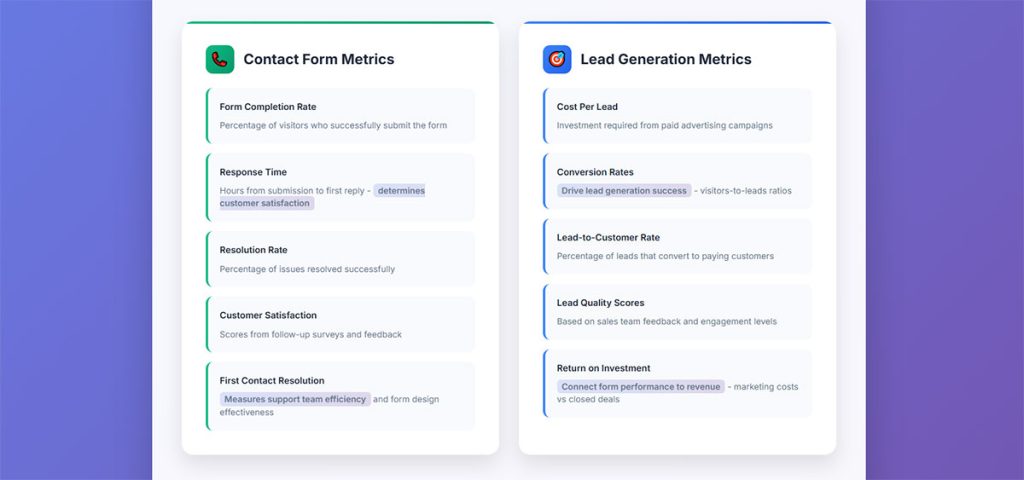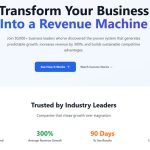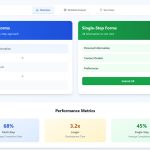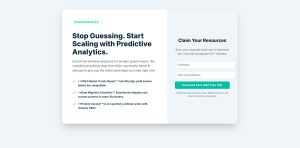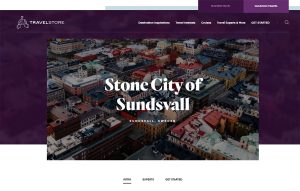Empty treadmills don’t pay bills. Fitness centers compete against Planet Fitness, Anytime Fitness, and boutique studios on every corner. Lead generation for gyms separates the survivors from the closures. The…
Table of Contents
Every website form serves a different purpose, yet many businesses use the wrong type for their goals. Understanding contact forms vs lead generation forms determines whether you build stronger customer relationships or drive more sales.
Contact forms handle customer service inquiries and general questions. Lead generation forms capture prospects and fuel sales pipelines. The distinction matters because each form type requires different design strategies, data collection approaches, and follow-up processes.
Choosing incorrectly costs conversions and frustrates users. This guide reveals when to use each form type, how to optimize their performance, and which technical features drive the best results.
You’ll discover:
- Key purposes and strategic applications for each form
- Design differences that impact user experience
- Data collection strategies for customer service versus sales
- Follow-up workflows that maximize form value
- Real-world examples from successful implementations
Contact Forms vs Lead Generation Forms
Key Purposes and Goals: Why Each Form Type Exists

Contact Form Objectives
Customer service takes center stage with contact forms. These forms handle support requests, technical issues, and general inquiries from existing customers. The primary goal stays simple: connect visitors with your support team quickly.
Most businesses use contact forms to build basic communication channels. Visitors can ask questions about products, report problems, or request information without picking up the phone.
Response speed matters more than conversion volume for customer service. Research shows that 90% of customers rate an “immediate” response as important, with 60% defining immediate as 10 minutes or less. This explains why contact forms typically have simpler designs focused on gathering essential information quickly.
Customer support teams rely heavily on these forms. They create structured workflows that route inquiries to the right departments automatically.
Contact forms average just 1% conversion rates – but this reflects their purpose. They serve existing customers who need help, not prospects ready to buy.
Lead Generation Form Objectives
Sales pipeline development drives everything with lead generation forms. These forms identify potential buyers and collect qualifying information that helps sales teams prioritize their efforts.
The main objective focuses on prospect qualification. Marketing teams use these forms to separate serious buyers from casual browsers through strategic questioning.
Nearly 50% of marketers say web forms are their highest converting lead generation tool, making them essential for business growth. The average lead-to-MQL conversion rate sits at 31% across industries.
Building marketing lists becomes much easier when you design forms specifically for lead capture. Each submission adds valuable prospect data to your CRM system.
Lead scoring happens automatically when you collect the right information upfront. Budget ranges, timelines, and company size help sales teams focus on high-value opportunities.
Form design impacts results significantly. Reducing form fields from 4 to 3 increases conversion rates by almost half, while multi-step forms achieve 86% higher conversion rates than single-page versions.
Strategic Business Applications
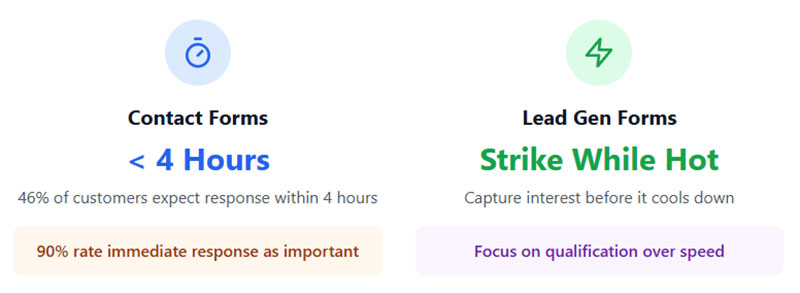
Timing determines which form type works best for your business goals. Customer service forms work perfectly when you need to support existing customers or handle general inquiries quickly.
Lead generation forms shine during marketing campaigns and sales initiatives. They capture prospects when interest peaks and buying intent is high.
Response expectations differ dramatically between form types. Customer service inquiries expect responses within 4 hours from 46% of customers, while lead forms focus on capturing interest before it cools.
Balancing immediate help with long-term growth requires careful consideration. Support forms build customer satisfaction and retention. Lead forms drive new business and revenue growth.
Different stages of the customer journey call for different approaches:
- Awareness stage: Simple contact forms for basic information
- Consideration stage: Lead generation forms with qualifying questions
- Decision stage: Both forms depending on user intent
With 84% of marketers using form submissions to generate leads, the strategic choice between contact and lead generation forms becomes critical for business success.
Design and Structure Differences That Shape User Experience
Contact Form Design Elements

Simplicity wins with contact forms. These forms typically feature minimal required fields and focus on removing friction from the inquiry process.
The average B2C contact form contains just 3 fields, which delivers the best conversion rates for customer service interactions. This streamlined approach matches user expectations for quick support access.
Most effective contact forms include:
- Name and email fields
- Subject line dropdown
- Large text area for detailed messages
- Optional phone number field
Open text areas give visitors freedom to explain their specific situations. This flexibility helps customer service teams understand problems better and provide more accurate responses.
Basic contact information collection keeps form design clean and approachable. Too many fields create barriers that prevent people from reaching out for help.
Research shows that removing even a single field can boost completion rates by 25%, making minimalism essential for contact forms.
Lead Generation Form Design Elements
Strategic field selection separates qualified prospects from casual visitors. Every field serves a specific purpose in the lead qualification process.
The average B2B lead form uses 5 fields, striking the optimal balance between data collection and conversion rates. This length allows proper qualification without overwhelming prospects.
Progressive profiling techniques work exceptionally well for lead generation. You can start with basic information and gradually collect more detailed data through multiple interactions.
Conversion-focused visual design uses compelling headlines, benefit statements, and social proof elements. These forms often include:
- Value proposition statements
- Testimonial quotes
- Trust badges and security indicators
- Clear call-to-action buttons
Multi-step forms achieve 86% higher conversion rates than single-page versions, though only 40% of marketers currently use this powerful approach.
Lead generation forms frequently incorporate conditional logic that shows different fields based on previous answers. This personalization improves user experience while collecting relevant qualification data.
User Interface Considerations
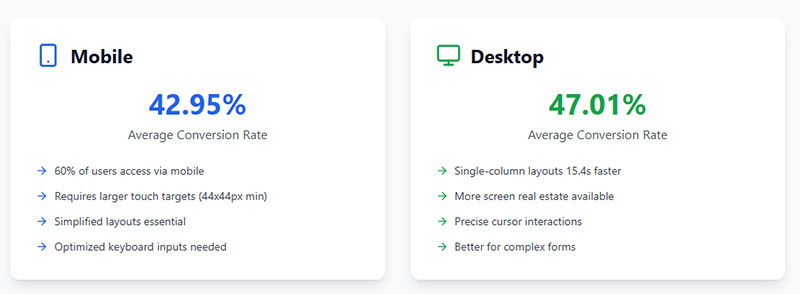
Form length directly impacts completion rates across both form types. Contact forms can be longer because users have specific problems to solve. Lead generation forms need careful balance between information gathering and conversion optimization.
Field placement affects user engagement significantly. Logical flow guides visitors through the form naturally:
- Start with easy fields (name, email)
- Progress to specific questions (company, role)
- End with qualifying information (budget, timeline)
Single-column layouts work best for both form types. Users complete single-column forms an average of 15.4 seconds faster than multi-column designs.
Mobile responsiveness becomes critical for both form types. Over 60% of global internet users access websites via mobile devices, making mobile optimization essential.
Mobile forms require different design considerations:
- Larger touch targets (minimum 44×44 pixels)
- Simplified layouts
- Optimized keyboard inputs
- Reduced field requirements
Mobile conversion rates differ from desktop: mobile devices average 42.95% conversion rates while desktop platforms achieve 47.01%.
Error Handling and Validation Strategy

Form UX design principles apply differently to each form type. Contact forms prioritize clarity and ease of use. Lead generation forms balance user experience with conversion optimization.
Error handling varies between form types. Contact forms need forgiving validation that helps users complete their requests. Lead generation forms require stricter validation to ensure data quality for sales teams.
Inline validation delivers impressive results: 22% fewer form errors and 42% faster completion times. This technique works particularly well for lead generation forms where data accuracy matters.
Button text impacts completion significantly. Generic “Submit” buttons cause 3% more form abandonment compared to action-oriented alternatives like “Get Started” or “Download Now.”
Form validation techniques should match the form’s purpose. Support forms can accept incomplete information if the user’s intent is clear. Lead forms need complete, accurate data for effective follow-up.
Security concerns drive 29% of form abandonments. Adding trust badges can increase overall conversions by 16%, making them valuable for both contact and lead generation forms.
Information Collection Strategies: What Data Each Form Gathers
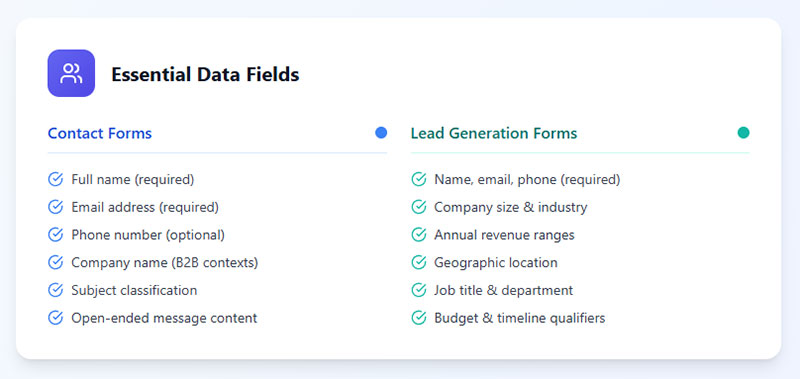
Contact Form Data Collection
Basic contact details form the foundation of every inquiry form. Name and email address remain standard requirements across most contact forms.
Contact forms typically capture minimal data to reduce friction. With 9.09% of individuals who encounter contact forms choosing to submit them, keeping field requirements simple becomes crucial for completion rates.
Essential contact form fields include:
- Full name
- Email address
- Phone number (often optional)
- Company name (for B2B contexts)
Subject classification helps route inquiries to appropriate departments. Dropdown menus with predefined categories streamline the support process and improve response times.
Open-ended message content provides the most valuable information. Large text areas allow customers to describe their specific situations, problems, or questions in detail.
Most effective contact forms avoid collecting unnecessary data. The goal stays focused on establishing communication, not building comprehensive customer profiles.
Research shows that 11% of users receive no contact at all from companies after filling out forms, highlighting the importance of efficient data handling and prompt follow-up processes.
Lead Generation Form Data Collection
Demographic information drives lead qualification. Name, email, phone number, and company details provide essential prospect identification data.
B2B lead generation requires more strategic data collection. The average B2B business generates about 1,800 leads per month, while mid-sized businesses typically produce less than 500 qualified leads monthly.
Firmographic information becomes crucial for B2B lead generation:
- Company size (number of employees)
- Industry or business sector
- Annual revenue ranges
- Geographic location
- Job title and department
Budget qualifiers separate serious prospects from casual browsers. Questions about budget ranges, project timelines, and purchase authority help sales teams prioritize their efforts.
68% of B2B businesses use personalized landing pages to produce leads through sponsored advertising, demonstrating the importance of tailored data collection approaches.
Interest level indicators include:
- Specific product or service interests
- Current solution evaluation stage
- Decision-making timeline
- Pain points and challenges
Progressive profiling delivers better results. Lead capture forms often use this technique to collect additional information through multiple interactions rather than overwhelming prospects with lengthy initial forms.
The fastest way to get accurate firmographic data involves collecting information upfront on lead sign-up forms and landing pages, especially for high-intent pages like demo requests or free trials.
Data Quality and Collection Efficiency
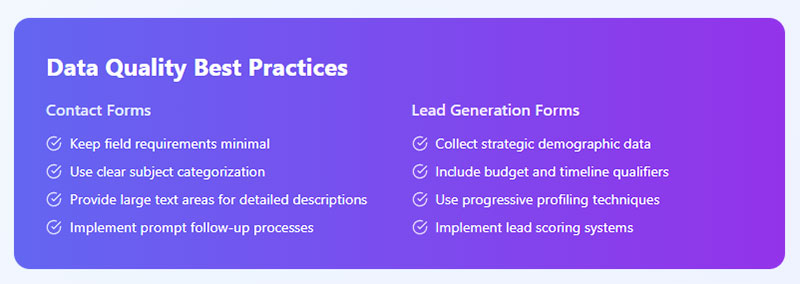
Email collection forms convert at higher rates than general contact forms. Email collection forms achieve an average conversion rate of 15%, significantly higher than standard form averages.
The average number of form fields across all forms is 5, but contact forms typically use fewer fields while lead generation forms may require more strategic data points.
Third-party data enrichment tools can provide extensive firmographic information, though there’s always slight risk of outdated data. Popular tools include Clearbit, InsideView, and ZoomInfo for supplementing form-collected data.
Privacy and Compliance Considerations

GDPR requirements affect data collection strategies significantly. Both form types must include clear consent mechanisms and privacy policy references.
Under GDPR, consent must be freely given, specific, informed, and unambiguous. This means forms cannot use pre-ticked boxes, implied consent, or bundled consent requests.
GDPR compliant forms require explicit consent for different data processing purposes:
- Customer service communication
- Marketing communications
- Sales follow-up activities
- Data sharing with third parties
Consent mechanisms vary based on form purpose. Contact forms need service-related consent. Lead generation forms require marketing and sales consent with clear opt-out options.
Data retention policies differ between form types. Contact form data typically gets stored for customer service purposes. Lead generation data feeds into longer-term marketing and sales processes.
Organizations must maintain records of all consent, including what users consented to, when they gave consent, and how they provided it. For online consent, records should include data submitted plus timestamps linking to relevant form versions.
Withdrawal must be as easy as giving consent. GDPR requires that users can withdraw consent at any time, and this process must be simple and accessible.
The separation of consent requests is mandatory under GDPR. You cannot bundle consent for legal policies with newsletter sign-ups or other marketing activities.
Businesses collecting special category data (health information, racial/ethnic origin, political opinions) face additional requirements and typically need explicit written consent beyond standard form consent mechanisms.
Follow-Up Processes: How Responses Differ After Form Submission
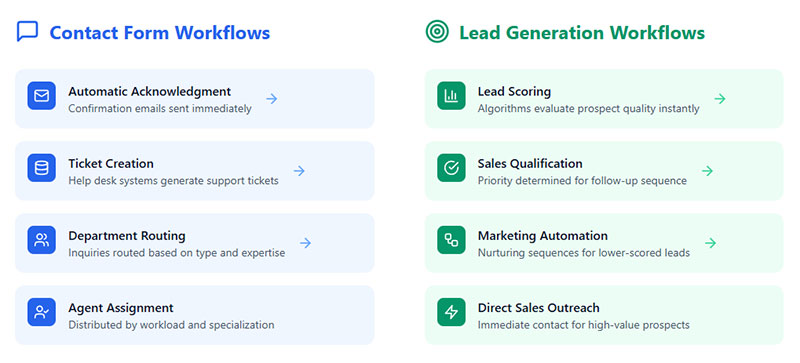
Contact Form Response Workflows
Customer service teams handle contact form submissions through established ticket routing systems. Most organizations use help desk software to manage inquiry distribution and tracking.
Response workflows typically include:
- Automatic acknowledgment emails confirm form submission
- Ticket creation in customer service systems
- Department routing based on inquiry type
- Agent assignment according to expertise and workload
Response time expectations vary by industry and inquiry type. Technical support issues often require faster responses than general information requests.
Most successful contact form processes include escalation procedures for complex issues that require specialized expertise or management attention.
Lead Generation Form Response Workflows
Sales team notifications trigger immediately after lead form submissions. CRM systems like Salesforce and HubSpot automatically create new lead records and assign them to appropriate sales representatives.
Lead response workflows involve multiple steps:
- Lead scoring algorithms evaluate prospect quality
- Sales qualification determines follow-up priority
- Marketing automation sequences begin for lower-scored leads
- Direct sales outreach initiates for high-value prospects
Lead nurturing sequences support long-term conversion. Marketing automation platforms like Marketo and Pardot deliver targeted content based on prospect interests and behaviors.
ActiveCampaign and ConvertKit excel at creating sophisticated nurturing campaigns that guide prospects through the sales funnel over time.
Technology Integration Requirements
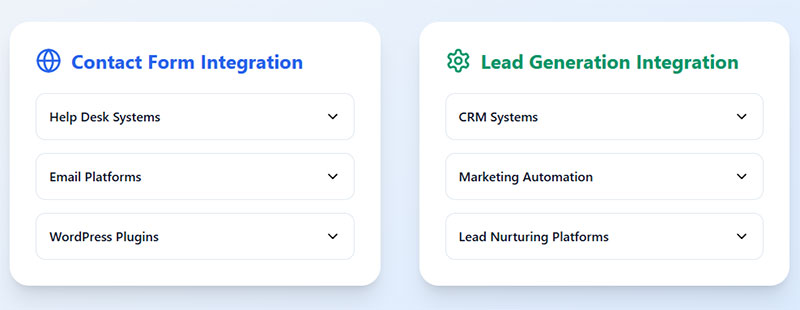
CRM integration becomes essential for lead generation forms. Systems like Salesforce, HubSpot, and Zoho capture lead data automatically and trigger follow-up processes.
Contact forms typically integrate with:
- Help desk systems (Zendesk, Freshdesk)
- Email platforms (Gmail, Outlook)
- WordPress contact form plugins
Marketing automation platforms handle lead generation form integration. Popular tools include:
- HubSpot Marketing Hub
- Marketo Engage
- Pardot (Salesforce)
- ActiveCampaign
- Mailchimp
WordPress lead generation plugins simplify integration for website owners using WordPress. These plugins connect forms directly to CRM systems and email marketing platforms.
Database integration ensures data consistency across all customer touchpoints. Lead generation forms feed prospect information into sales pipelines while contact forms update customer service records.
API connections enable real-time data synchronization between forms and backend systems. This integration prevents data silos and improves team collaboration across sales, marketing, and customer service departments.
Conversion Optimization Techniques for Each Form Type
Contact Form Optimization Methods
Reducing friction drives completion rates for customer service forms. Remove unnecessary fields and focus on essential contact information only.
Key optimization strategies include:
- Single-column layouts for better mobile experience
- Clear field labels that explain what information is needed
- Optional field indicators to reduce perceived complexity
- Smart defaults for common inquiry types
Trust signals become crucial for contact forms. Security badges, privacy policy links, and company contact information build confidence in visitors hesitant to share personal details.
Improving form abandonment rate requires careful attention to user experience. Save progress automatically and provide helpful error messages when validation fails.
Response time promises increase conversions. Clear statements about when customers can expect replies reduce anxiety about form submissions.
Lead Generation Form Optimization Methods
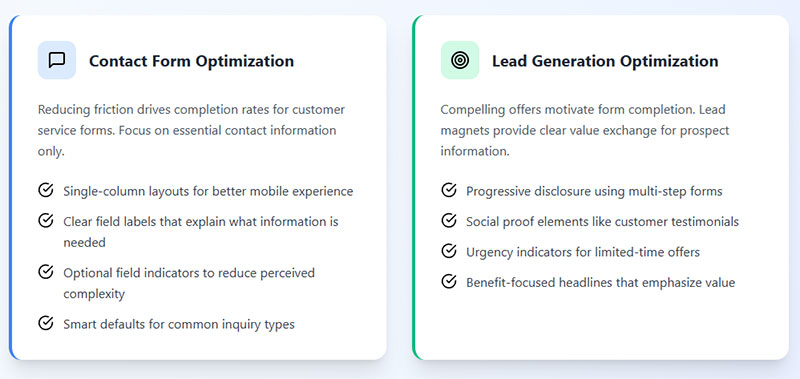
Compelling offers motivate form completion. Lead magnets like free guides, templates, or consultations provide clear value exchange for prospect information.
Effective lead generation optimization includes:
- Progressive disclosure using multi-step forms
- Social proof elements like customer testimonials
- Urgency indicators for limited-time offers
- Benefit-focused headlines that emphasize value
Landing page forms require alignment between ad copy and form messaging. Consistent value propositions reduce cognitive dissonance and improve conversion rates.
A/B testing reveals optimization opportunities. Test different form lengths, field arrangements, and call-to-action buttons to identify highest-performing combinations.
Tools like Unbounce and Leadpages make testing simple with built-in analytics and variation management.
Common Optimization Mistakes to Avoid
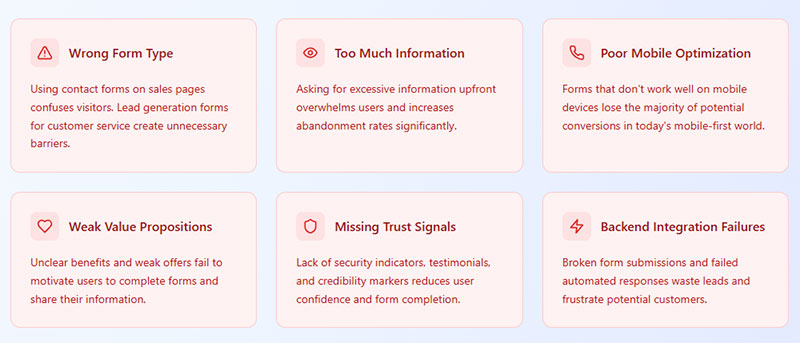
Using the wrong form type kills conversions. Contact forms on sales pages confuse visitors. Lead generation forms for customer service create unnecessary barriers.
Common mistakes include:
- Asking for too much information upfront
- Poor mobile optimization
- Weak value propositions
- Missing trust signals
- Confusing field labels
Backend integration failures waste leads and frustrate customers. Test form submissions regularly to ensure proper data routing and automated responses work correctly.
Measuring Success: Key Metrics for Each Form Type
Contact Form Performance Metrics
Response time determines customer satisfaction with support forms. Track average response times and ensure they meet service level agreements.
Critical contact form metrics:
- Form completion rate (percentage of visitors who submit)
- Response time (hours from submission to first reply)
- Resolution rate (percentage of issues resolved)
- Customer satisfaction scores from follow-up surveys
Support ticket volume trends reveal form effectiveness. Declining submission rates might indicate form problems or improved self-service options.
First contact resolution rates measure support team efficiency. Higher rates indicate better form design that captures necessary problem details upfront.
Lead Generation Form Performance Metrics
Conversion rates drive lead generation success. Track visitors-to-leads ratios across different traffic sources and form variations.
Essential lead metrics include:
- Cost per lead from paid advertising campaigns
- Lead-to-customer conversion rates
- Lead quality scores based on sales team feedback
- Marketing qualified lead (MQL) percentages
Sales team input becomes crucial for measuring lead quality. Track which form sources produce customers with highest lifetime value.
Return on investment calculations connect form performance to revenue. Compare marketing costs against closed deals from each lead source.
Analytics Setup and Tracking
Google Analytics goal configuration tracks form completions and conversion funnels. Set up events for form starts, field completions, and successful submissions.
CRM reporting provides deeper lead analysis. Salesforce, HubSpot, and Pipedrive offer built-in analytics for lead source performance and sales progression.
Regular performance reviews identify optimization opportunities. Monthly analysis of conversion rates, lead quality, and customer feedback guides form improvements.
Dashboard creation in tools like Tableau or Google Data Studio combines data from multiple sources for comprehensive performance views.
Technical Implementation and Best Practices
Contact Form Technical Requirements
Spam protection prevents unwanted submissions. Implement reCAPTCHA, honeypot fields, or rate limiting to block automated form abuse.
Essential security measures include:
- SSL certificates for encrypted data transmission
- Input validation to prevent malicious code injection
- CSRF tokens to prevent cross-site request forgery
- Regular security updates for form plugins
Form security extends beyond basic spam protection. Validate all inputs server-side and sanitize data before database storage.
Email delivery systems require proper configuration. Set up SPF, DKIM, and DMARC records to ensure form notifications reach intended recipients.
Lead Generation Form Technical Requirements
Integration with marketing tools enables automated lead nurturing. Connect forms to Mailchimp, ActiveCampaign, or ConvertKit for immediate email sequence activation.
Advanced form features include:
- Progressive profiling that remembers previous submissions
- Dynamic field population from URL parameters
- Conditional logic for personalized experiences
- Real-time validation with helpful error messages
CRM integration requires API connections or webhook configuration. Test data flow from forms to ensure leads appear correctly in sales systems.
Progressive web app considerations improve mobile form performance. Implement service workers for offline form completion and background synchronization.
Maintenance and Updates
Regular testing prevents form failures. Check submission processes monthly and verify all integrations work correctly.
Quality assurance includes:
- Cross-browser compatibility testing
- Mobile device validation across different screen sizes
- Load testing for high-traffic periods
- Error handling verification
Form builder with conditional logic tools like Gravity Forms and WPForms simplify maintenance with visual editors and automated updates.
Security patches require immediate attention. Update form plugins, WordPress core, and server software regularly to prevent vulnerabilities.
Business requirement changes demand form field updates. Add new qualification questions, modify routing rules, or update integration endpoints as needed.
Performance monitoring catches problems before they affect conversions. Set up alerts for unusual submission patterns or integration failures.
FAQ on Contact Forms Vs Lead Generation Forms
What’s the main difference between contact forms and lead generation forms?
Contact forms handle customer service inquiries and general questions from existing or potential customers. Lead generation forms specifically capture prospect information to build sales pipelines and identify potential buyers through qualifying questions.
When should I use a contact form instead of a lead generation form?
Use contact forms for customer support, general inquiries, and information requests. They work best on contact us pages where visitors need help rather than sales assistance.
How many fields should each form type have?
Contact forms need minimal fields: name, email, subject, and message. Lead generation forms can include more qualifying fields like company size, budget, and timeline without hurting conversion rates significantly.
Which form type converts better for sales?
Lead generation forms convert better for sales because they capture qualified prospects with purchase intent. Contact forms generate inquiries but don’t necessarily indicate buying readiness or budget qualification.
Can I combine both form types on one page?
Yes, but use clear messaging to differentiate purposes. Offer separate forms for “Get Support” and “Request Demo” or use conditional logic to branch users based on their intent.
What CRM integrations work best for each form type?
Contact forms integrate well with help desk systems like Zendesk. Lead generation forms connect to CRM platforms like Salesforce, HubSpot, and Pipedrive for sales pipeline management and nurturing sequences.
How do follow-up processes differ between form types?
Contact forms trigger customer service workflows with response time expectations. Lead generation forms activate sales processes including lead scoring, qualification calls, and automated email nurturing through marketing automation platforms.
Should mobile design differ for each form type?
Both need mobile optimization, but lead generation forms require more careful field selection for smaller screens. Contact forms can maintain longer message areas for detailed problem descriptions.
Which metrics matter most for measuring success?
Contact forms: response time, resolution rate, customer satisfaction. Lead generation forms: conversion rate, cost per lead, lead quality scores, and sales conversion rates from CRM data.
What security considerations apply to each form type?
Both need SSL encryption and spam protection. Lead generation forms require stronger data validation and GDPR compliance for marketing consent. Contact forms focus on secure message transmission.
Conclusion
Choosing between contact forms vs lead generation forms determines your website’s ability to serve customers and capture prospects effectively. Each form type serves distinct business objectives that require different design approaches and backend integrations.
Contact forms excel at customer service and general inquiries. They build communication channels with minimal friction while routing support requests to appropriate teams through help desk systems.
Lead generation forms drive sales pipelines by capturing qualified prospects. Progressive profiling, conditional logic, and CRM integration with platforms like Marketo and ActiveCampaign maximize lead quality and conversion tracking.
Success depends on matching form type to user intent. Implement the right form for each page purpose:
- Customer support pages need contact forms
- Marketing campaigns require lead generation forms
- Landing pages benefit from conversion-focused designs
Regular testing, proper analytics setup, and form optimization ensure both form types deliver maximum value for your business goals.


